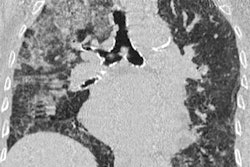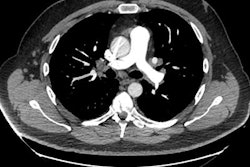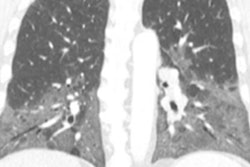
Radiologists have an essential part to play in using CT to diagnose and monitor immune-related adverse events in the chest, according to prize-winning researchers from a top hospital in Barcelona, Spain. Optimal patient care during immunotherapy requires multidisciplinary effort by pulmonologists, medical oncologists, and radiologists, they say.
"A combination of diagnostic clues at imaging and clinical manifestations in a multidisciplinary context can contribute to accurate diagnosis and optimal treatment of thoracic immune-related adverse events," noted Dr. Mariana Benegas Urteaga, a thoracic radiologist at the Hospital Clínic of Barcelona, and her colleagues. "High-resolution CT (HRCT) is the preferred diagnostic study when pulmonary immune-related toxicity is suspected."
It's important to get to know the thoracic complications related to therapy with immune-checkpoint inhibitors, they explained in an e-poster presentation that received a cum laude award at ECR 2019 in Vienna. This inspired the researchers to develop an easy and schematic diagnostic approach to these adverse events with a combination of imaging and clinical features.
Pulmonary toxicity of cancer immunotherapies is an important clinical event that requires prompt identification and management, the authors wrote.
"Once suspected, HRCT is the preferred diagnostic study, because chest radiography fails to detect up to one-quarter of these cases. In this context, HRCT can be used as an imaging biomarker to assess drug toxicity," they continued. "The radiologic manifestations of immune-related adverse events in the lung comprise a broad and overlapping spectrum of pulmonary manifestations."
Radiologic patterns of immune-related pneumonitis have been characterized according to the American Thoracic Society (ATS) and European Respiratory Society (ERS) classification of interstitial pneumonias, and recognition of the radiologic patterns of pneumonitis is the first step in the image-based approach, Benegas Urteaga stated.
Radiologic patterns associated with immune-related pneumonitis include the following:
- Acute interstitial pneumonia (AIP)/acute respiratory distress syndrome (ARDS) pattern
- Nonspecific interstitial pneumonia pattern
- Cryptogenic organizing pneumonia pattern
- Hypersensitivity pneumonitis pattern
"The clinical course and the radiographic patterns are variable among patients," they pointed out. "Some patients have a fulminant clinical course with rapidly worsening respiratory that require admission to the intensive care unit and intubation with AIP/ARDS pattern on chest CT."
Other patients have a milder clinical course, with CT findings indicative of nonspecific interstitial pneumonia, cryptogenic organizing pneumonia, and hypersensitivity pneumonitis patterns.
Emergence of immunotherapy
Immunotherapy has evolved into a promising treatment option for advanced cancer and is now considered the standard of care for multiple cancers, the authors emphasized.
"Immune checkpoint inhibitors have shown remarkable beneficial effects in several cancer types, including lung cancer, kidney cancer, melanoma, head and neck cancer, bladder cancer, lymphoma, and Merkel cell cancer," they wrote.
The anticancer activity of immune checkpoint inhibitors is due to the blockade of immune inhibition by tumors, which activates T-cell-mediated immune responses against tumors, Benegas Urteaga explained.
"Immune checkpoint inhibitors are monoclonal antibodies that target natural immune checkpoints such as cytotoxic T-lymphocyte antigen 4 (CTLA-4), programmed death 1 (PD1), and PD ligand 1 (PDL1). Such checkpoints prevent the development of antihost immune effects, which would otherwise result in clinical autoimmune disease, thus checkpoint inhibitors might lead to enhanced antitumor immunity," they stated.
Currently approved drugs in this class include ipilimumab, a CTLA-4 inhibitor; pembrolizumab and nivolumab, PD1 inhibitors; and durvalumab, atezolizumab, and avelumab, which are PDL1 inhibitors.
To view the full e-poster and clinical images, go to the Spanish exhibit in the Electronic Presentation Online System (EPOS) from ECR 2019.



















